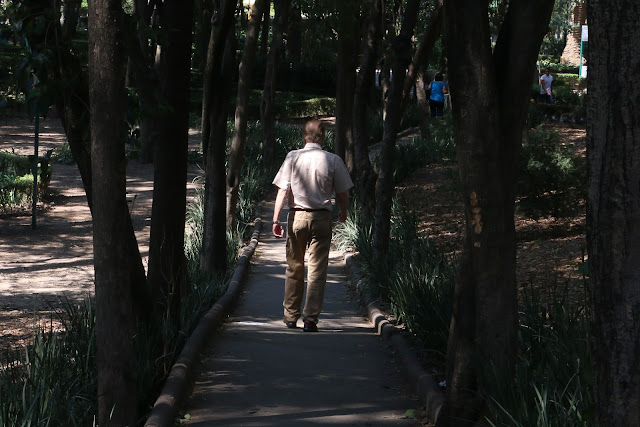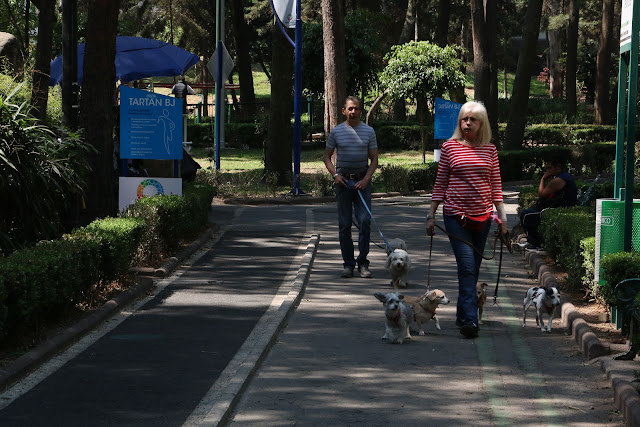During a visit to Mexico City before moving here in 2011, we were taking the Metrobus down Avenida Insurgentes. The Metrobus is a double bus, styled rather like two joined subway cars, with two wide doors on one side of each car. It has its own, dedicated lane and raised platforms for passengers to exit and enter at designated stops. Avenida Insurgentes is lined with trees and many modern office buildings, stores and restaurants, so we enjoyed a pleasant ride.
Traveling along, we glimpsed what appeared to be a wooded park, but strangely, it dropped below street level, out of sight. This piqued our curiosity, but during that visit to Mexico City, we didn't have time to return and investigate it. After we moved to Coyoacán in southern Mexico City, we had many other parts of the metropolis to get to know. We finally passed by it again while exploring the original pueblo of Mixcoac, but our focus then was on the landmarks of the Spiritual Conquest, the churches established during the evangelization of the indigenous residents by Spanish friars in the 16th century.
Eventually, we did return and get to know the park below ground level. It is, in fact, popularly called Parque Hundido, the Sunken Park, and it has become one of our favorite parks in Mexico City. It provides a wooded, therefore shady, cool retreat from the urban barullo (hubbub) and the Mexican sun. It is much smaller than Chapúltepec Woods, so it can be explored in its totality during a leisurely walk. There are many benches for resting and people watching. It is never crowded. Like Parque de los Venados (Deer Park), also in Delegación Benito Juárez, it is more of a neighborhood park, used by the people living around it.
Parque Hundido's below street level setting is the result of the transformation of a site, now in Delegación Benito Juárez, that was occupied by the Nochebuena (Good Night) Brick Company during the 19th century. Near the beginning of the Porfiriato (dictatorship of Porfirio Díaz, 1876-1911), the company moved away, likely because it had dug out all the clay from the former lake bed. It left an empty depression.
Traveling along, we glimpsed what appeared to be a wooded park, but strangely, it dropped below street level, out of sight. This piqued our curiosity, but during that visit to Mexico City, we didn't have time to return and investigate it. After we moved to Coyoacán in southern Mexico City, we had many other parts of the metropolis to get to know. We finally passed by it again while exploring the original pueblo of Mixcoac, but our focus then was on the landmarks of the Spiritual Conquest, the churches established during the evangelization of the indigenous residents by Spanish friars in the 16th century.
Eventually, we did return and get to know the park below ground level. It is, in fact, popularly called Parque Hundido, the Sunken Park, and it has become one of our favorite parks in Mexico City. It provides a wooded, therefore shady, cool retreat from the urban barullo (hubbub) and the Mexican sun. It is much smaller than Chapúltepec Woods, so it can be explored in its totality during a leisurely walk. There are many benches for resting and people watching. It is never crowded. Like Parque de los Venados (Deer Park), also in Delegación Benito Juárez, it is more of a neighborhood park, used by the people living around it.
From Brick Factory to Good Night Woods
Parque Hundido's below street level setting is the result of the transformation of a site, now in Delegación Benito Juárez, that was occupied by the Nochebuena (Good Night) Brick Company during the 19th century. Near the beginning of the Porfiriato (dictatorship of Porfirio Díaz, 1876-1911), the company moved away, likely because it had dug out all the clay from the former lake bed. It left an empty depression.
Near the end of the Porfiriato, in the late 19th and early 20th centuries, several species of trees were planted there, creating the Bosque de la Nochebuena, the Good Night Woods. This was likely under the direction of Miguel Ángel de Quevedo, an engineer and architect who worked in the Secretariat of Agriculture and became the champion of reforesting the then Federal District and, later, the Mexican countryside. He also created los Viveros de Coyacán, the Coyoacán Tree Nursery, to grow trees for transplanting around the City.
(La Nochebuena, the Good Night, is the Spanish name for Christmas Eve and, hence, also of the poinsettia shrub, native to Mexico, which flowers at Christmas time. The poinsettia derives its common English name from Joel Roberts Poinsett, the first U.S. Minister to Mexico, who introduced the plant to the United States in 1825. See our spouse's post in Jenny´s Journal of Mexican Culture: From Nochebuena—"Christmas Eve" Flower—to Poinsettia).
In the late 1930s, having paved and widened Avenida de los Insurgentes, a main road to the south, the city government decided to turn the woods into a park. In 1972, the space was redesigned. It is now a wonderful, jungle-like, quiet escape from the urban bustle above and around it. (Wikipedia)
A Walk in the Park
 |
| The main entrance to the park is a wide, formal stairway descending from Avenida Insurgentes. At the bottom is the park's signature floral clock. |
 |
| Our favorite entrance is from a small plaza at the corner of Insurgentes and Avenida Porfirio Díaz. A few stairs, made of rocks, descend to a pathway into the woods. |
 |
| Park's northeast corner, seen from below. |
 |
| Reaching the bottom, one finds a network of curving paths which make it easy and inviting to walk around the park and experience various perspectives. |
 |
| On the west side, a small hill adds visual interest and an opportunity for stair-climbing. |
Outdoor Sculpture Museum
 |
| Around the oval path are full-scale reproductions of a number of Mesoamerican (prehispanic) sculptures. This is an Olmec head from Veracruz. |
 |
| Chaac, Maya god of rains and waters. |
Things to Do in Parque Hundido
 |
| An oval path that circles the park has a rubber track for jogging or power walking. It´s also kind to those with back problems or mobility challenges. |
 |
| The park is a favorite for dog walkers. |
 |
| A "train" provides rides around the oval for those choosing not to wallk. |
  |
| Left: Trying out his "wheels" (Bikes are not allowed.) Right: Go, girls, go! |
 |
| Doing homework. |
 |
| Doing the teenage thing. |
 |
| A teenage boy takes after-school care of a group of younger kids. |
 |
| A little fútbol (soccer) practice is always in order. |
 |
| A quiet walk by one's self. |
Wooded Retreat Near City Centro
Parque Hundido is quite centrally located, not far south of Centro Histórico and easy to reach via the Metrobus on Avenida Insurgentes or via taxi. This makes it possibly the most accessible and enjoyable park in Mexico City for anyone seeking a quiet retreat.
 |
| Delegación Benito Juárez Parque Hundido (green/yellow star) is in Colonia Extremadura Insurgentes, west of Avenida Insurgentes. Just north of it is la Colonia Noche Buena (small purple rectangle) The park is a short walk north of the original pueblo of Mixcoac, (orange) about which we have written. |
 |
| Delegación Benito Juárez is bright yellow in north-center of Mexico City. It is just south of Delegación Cuauhtémoc (taupe), the location of Centro Histórico. and north of Delegación Coyoacán (purple). |

No comments:
Post a Comment